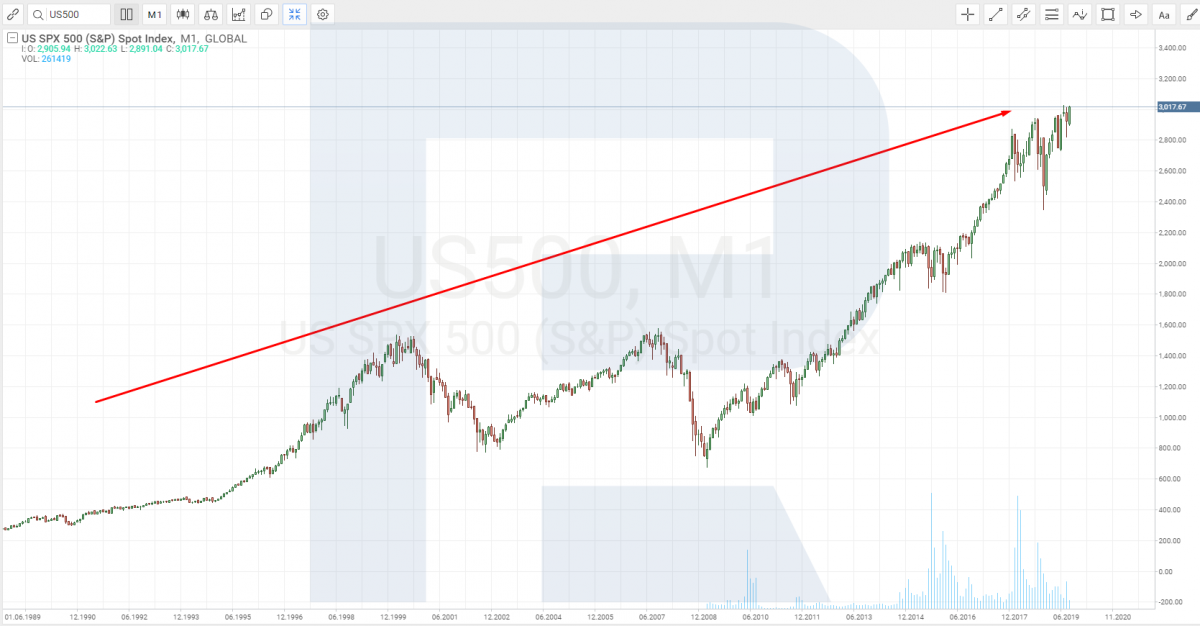What are ETFs? The Beginners Guide

6 minutes for reading
Exchange-Traded Funds and their types
Exchange-Traded Funds (ETF) are investment trust funds which stocks are traded on the exchange. An index ETF replicates the structure of its basic index. ETF stocks are available for the very same operations as normal stocks on any exchange. This is one of the advantages of the ETF: its stocks can be traded whole market day long as their price changes in accordance with the market behavior. In fact, the ETF stocks are a new type of securities that allows for buying a whole portfolio of stocks, bonds, currencies, etc. If we have a look at the leading stock indices, such as Dow Jones, S&P 500 or RTS, we shall see their charts demonstrate stable growth for many years, while the stocks of certain enterprises or even branches show both rises and falls.

So, for long-term investments and risk diversification buying an index suits better; but how do we do this? Gathering a portfolio of all stocks constituting the index requires a substantial sum of money (some stocks are quite expensive) and additional spendings on the fees. Here, an ETF on the desired index may be of good help. It features all the necessary securities in the right proportion, so for investment it will be enough to buy the desired amount of the ETF stocks. The entrance threshold will be minimal, and so will be the commission fee.
The first ETF appeared in Canada in 1990, then in 1993 in the USA there appeared an ETF on a popular S&P 500 index — Standard and Poor's 500 Depository Receipt (SPDR, ticker SPY), also known as spider among traders. Then, ETFs were gaining popularity, spreading all over the world. There are plenty of ETF types; we shall discuss the most important ones:
- Index ETFs copy the most popular world indices, giving a chance to make a profit on their growth.
- Commodity ETFs track price movements of different commodity assets: oil, gold, industrial metals, electricity, agricultural products, etc.
- Bond ETFs form portfolios of bonds from different countries and industry fields.
- Sector and industry ETFs specialize in the securities of companies engaged in one field of industry.
- Dividend ETFs are oriented at the stocks of large companies yielding substantial income from dividends.
- Special ETFs are engaged in buying specific assets, such as real estate funds.
- Inverse ETFs grow when the price for the basic asset falls, allowing to earn on its falling.
How and where to trade the ETF?
The ETF can be traded in many ways. It may be traded speculatively, intraday, mid-term or as long-term investments; the ETF may also be used for hedging. Everything depends on your trading strategy: for long-term investment, the fundamental analysis seems better, while short-term speculations require technical analysis.
ETFs with good liquidity and a narrow spread are excellent trading instruments. One of the most liquid is the SPY — the ETF on the S&P 500 index; it is actively traded on the wide market in the USA; this fund is extremely popular among traders. For trading, you will have to open an account in a broker company, providing access to the ETF. Next, via a trading terminal, you choose an ETF and make a buy, same as with any other trading instrument. For example, RoboForex allows for trading various ETFs through the R StocksTrader terminal.

CFD vs ETF: active trading or passive investments
The ETF is mostly an instrument for passive investments. The main idea of passive investments is making as few movements as porssible and avoid running ahead of the market. A long-term investor does not use leverage, does not sell short, does not use derivative instruments like futures and options. It is enough to choose a suitable ETF, buy it and keep it until the planned revenue is received; the commission fee is minimal, and on some ETFs, you can even receive dividends.
A CFD (Contract For Difference) is a marginal instrument for more active, short-term speculative trading. The commission fee is slightly higher here; leverage of 1:10 or 1:20 is often used. Also, you will have to pay the spread (the difference between the price of the buy and sell) and the fee for a rollover. Thanks to the leverage, your trading opportunities are enhanced — you can buy more stocks; however, the risks also increase. You need to be more attentive to the market, to learn to forecast possible market movements — all in all, this instrument is more suitable for traders than for investors.
Advantages and drawbacks of the ETF
The advantages are as follows:
- Easy-to-trade and available;
- Transparent and clear portfolio structure;
- Access to investments into various international markets from one account;
- Compatibility with different trading strategies, passive ("buy and keep") and active likewise;
- A low initial threshold — you can invest rather few money;
- High liquidity — you can always buy and sell quickly;
- Diversification, as buying an ETF is buying the instruments included in this fund.
The drawbacks, then, would be:
- Trading fees — the ETF gathers a management fee;
- A possible increase in risks due to the use of leverage;
- Uniformity — it is important to understand the structure of your ETF in order to avoid investing in similar instruments and to reach the necessary diversification level.
On the whole, there are more advantages than drawbacks, especially in comparison with mutual funds.
The largest ETF suppliers
The ETF market is active, competitive, and constantly growing. At the same time, there are obvious leaders; for example, 80% of the whole ETF turnover in the USA belongs to 3 leading suppliers:
- BlackRock's iShares ETF owns the biggest series of investment funds iShares, bought during the merging of Barclays Global Investors in 2009. It includes more than 500 funds and almost 650 billion dollars.
- Vanguard ETF is a company, founded in 1975, which unites some 370 funds and holds more than 5.8 billiard dollars. Vanguard provides investors with actively managed ETFs; the company also pursues the reduction of expenses for passively managed funds. The company's characteristic feature is its belonging to its own funds.
- SPDR ETF by State Street Global Advisors is a company founded in 1972 and suggesting more than 100 ETF. Most of them are known as SPDR funds. SPDR S&P 500 ETF (SPY) is the oldest and the largest ETF owning almost 125 billion dollars and mostly traded all over the world







